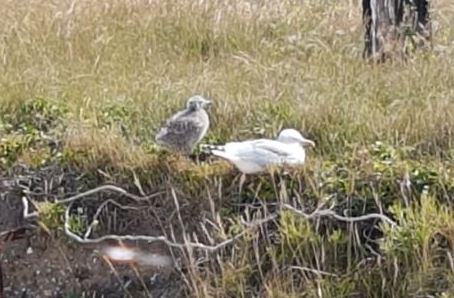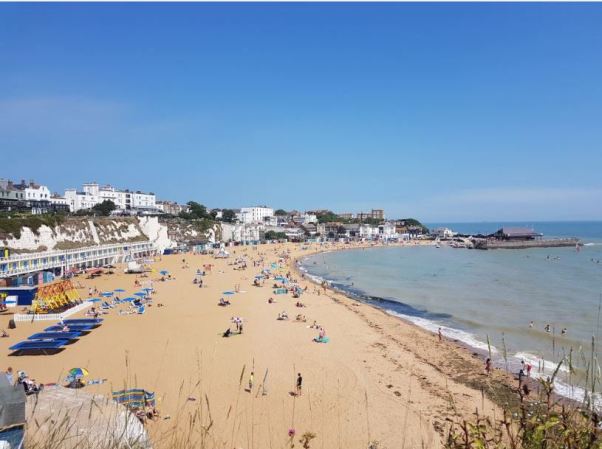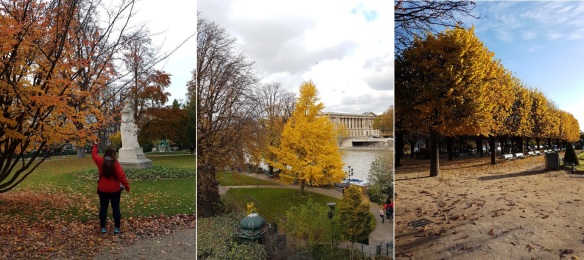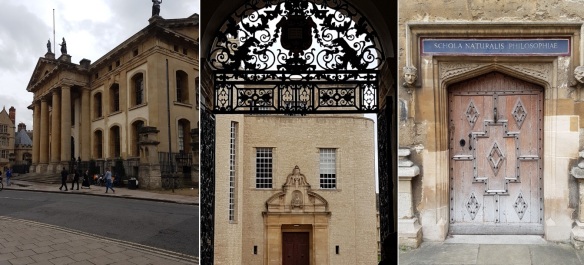The Easter long weekend is done and it has glowered and grizzled and pretty much rained for the whole four days. This morning, the weather forecast touted a high of 14C for London but having just come back from running a couple of errands up the street, it feels like more of the same damp squib to me.
*sigh*
It’s led me to reminisce about sunnier times – like when I spent a warm summer weekend in Kent last July.
It was a ‘big birthday’ for stepmum-B’s Mum. B had flown into London earlier in the week and had been staying at Chez Gidday for a few days so we headed into London’s Friday afternoon commuter swell and down to Kent together for a weekend of family catch-ups and birthday festivities. The weekend proved to be gloriously warm and mostly sunny so aside from the party on Saturday evening, we were able to spend some time poking around a few of Kent’s picturesque and historic towns.
We began in Canterbury, the city that gave birth to Geoffrey Chaucer and his tales.

L: Statue of Geoffrey Chaucer in Castle Street; R: Lush gardens along the old city walls
Canterbury Cathedral is a must see. It’s chock full of glorious architecture…

Intricate carvings – including on the tomb of Henry IV and his queen, Joan of Navarre (right)

So many spectacular things to admire, it’s easy to lose track of time.
…and comes with somewhat of a chequered past.

L: Looking down the length of the cathedral from the Trinity Chapel; R: This memorial marks the site of the murder of the then Archbishop of Canterbury, Thomas Becket, in 1170.
And then there are Canterbury’s many pubs.

There’s a little bit of whatever takes your fancy here. Make sure you check out the old ducking stool around the corner from The Old Weavers House.
The local folk festival was on so we managed to catch the parade on Saturday morning…

Catching the start of the street parade for the folk festival.
…as well as popping into the Canterbury Museum for a spot of local history. To our surprise, we found this little piece of Down Under hanging on the wall.

On the Moira Station, Australia – oil on millboard – by P Lee, 1890.
After a pleasant morning, we were to meet up with some of the family for a pre-do catch up. However, things didn’t quite go according to plan so B’s brother took us to the town of Sandwich. Folkish pursuits having established themselves here too, we were regaled with some spirited morris dancing as soon as we arrived.

Morris dancing on the banks of the River Stour
Luckily there was also plenty of time to enjoy an ice-cream while wandering through the bustling main square and polish off some delicious fish and chips.
Sunday morning dawned and instead of the relaxed ambling we had counted on after the festivities of the night before, more plans had been developing and we had another family get-together to squeeze in before I caught my train. But there was still time for a quick trip to Botany Bay – the Kent version – for a look around.

Yes, there was a beach – with people swimming and everything. It was that warm…

The top picture is what’s known as either the Folly or Neptune’s Tower. (There’s quite a good post about it on Echoes of the Past if you are interested in finding out more.) We also introduced B’s brother and his girlfriend to geocaching here. The bottom picture is the view from the coastal path alongside the Folly.

A seagull and chick enjoying the sea air and sunshine.

Two more birds enjoying the sunshine and sea air of Botany Bay (that’s me on the right).
After a little basking in the sun at the Botany Bay Hotel – over a pretty decent coffee I might add – we headed off to our final shindig via the delightful seaside town of Broadstairs.

Viking Bay, Broadstairs – another beach with people swimming!
It was a flying stop, just long enough to get out of the car for ten minutes and admire the view, before driving on to our last family do of the weekend. More eating, drinking and gas bagging ensued…and then it was time to say my goodbyes. Before long I was sitting by the train window relaxed, sun-kissed and watching the Kent countryside, bathed in the soft light of a summer’s evening, whisk by.
The rain has stopped now and I’m pleased to report that it’s definitely feeling warmer at Chez Gidday – the toasty winter throw has been tossed aside and I have the kitchen window open a fraction to ‘freshen the air’.
But what I’m really hoping is that some proper sunshine is not far away, when it will be just warm enough to sit outside, albeit jumper-clad, to read or to relocate the chores I’ve been doing on the comfy couch. Let’s face it. While waxing nostalgic about summers past from the Gidday sofa has been a pleasant way to spend a rainy afternoon, I am definitely looking forward to tap-tap-tapping away on the back patio instead.
Fingers crossed that this will come sooner rather than later.























































